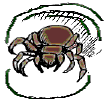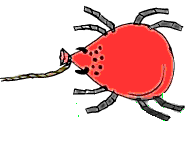Spiders - Lesson 4: Spiders Catch Prey
ACTIVITY: Spider Fun
Objectives
Students make observations about spiders, naming two kinds of spiders and
describing their webs and spiderlings.
Materials
scissors; glue; popsicle sticks; a tissue box; yarn; cutout of trap-door spiders;
flour and water; nylon thread; cardboard tube (from paper towels); newspaper;
paints or colors; markers; stapler; tape; construction paper; leaves, small
sticks; grass; one balloon per child; small brown paper bags
Procedures
Trap-door Spiders
- Use the tissue box with its lid, to form the trap door for the spider. The
spider hides inside the trap (or the box) until it senses through the web that
some prey is near.
- Glue the leaves and small sticks on the sides of the tissue box.
- Color and then glue the cutout of the trap-door spider on a popsicle stick.
- Students draw, color and cut out shapes of insects: ants, bees,
grasshoppers, flies, etc. (These can also be used for other activities.)
- Staple pieces of yarn to the insects to dangle close to the opening of the
trap door.
- One student dangles the insect while the spider pops out of the trap
door to get its prey.

Purse-Web Spiders
- Cut the cardboard paper towel tube in half to make two webs.
- Make a paper mache mix with the flour and water.
- Cut the thread into six-inch to eight-inch pieces; dip them in the mix and
wrap them around the tube. Let the thread dry.
- Color the tubes brown (for camouflage). Make the brown paper bags into
rocks by stuffing them with newspaper and gluing or stapling them shut.
- The purse (web) is now ready. Place it on the side of the rocks. The spider
digs a hole under the web. When insects get caught in the web, the spider
captures them. (Student pretends to be a spider and hides under the rocks [bags];
another student pretends to be an insect. When the "insect" touches the web, the
spider captures it. The "spider" pretends to eat the "insect".)
- Students take turns being the spider and the prey.
Flower Spiders
- Each student draws a daisy with a yellow center and white petals.
- They draw on the white petals a white spider waiting for an insect to come
by.
- The spider waits for the bee, butterfly or other insect to get close enough
to it, then it strikes its prey.
- This spider does not use its web to catch its prey. It relies entirely on
its camouflage to deceive the insect.
Spiderlings
Each child blows up a balloon and:
- counts and makes eight construction paper spider legs
- counts and colors in eight eyes at the front of the balloon
- makes two fangs on the sides close to the eyes
- tapes the eight legs to the spider balloons
- tapes a piece of yarn to the spider
- hangs the spider from an appropriate place in the classroom.
Students observe that air currents in the room make the spiderlings sway
and float.

Discussion
- How does the trap-door spider catch its prey? Does it build a web? How do
the leaves, sticks and grass help the spider? (The spider senses the vibrations
of the leaves and sticks and knows that prey is outside the trap.)
- How does the purse-web spider catch its prey?
- A spiderling can use its spinnerets as soon as it is born. The spiderling
puts out a silk line called a dragline. What do you suppose the spiderling uses
this line for? (To catch food.) How does it find food? As the spiderling sways on
its line, it can catch prey. This is called ballooning. Why?
|

